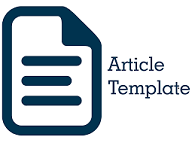Author Guidelines
Writing system follows the American Psychological Association (APA) 6th and note this following guidelines:
1. Type of Paper
- Research Article: Articles that report novel empirical findings or theoretical developments.
- Literature Review: Articles that capture the state-of-the-art in a newly emerging or rapidly progressing research area, and provide an overview of the most relevant literature and the major theoretical implications
2. Manuscript Submission
- Manuscript Type: Submission of a manuscript implies that the work described has not been published before; that it is not under consideration for publication anywhere else; that its publication has been approved by all co-authors, if any, as well as by the responsible authorities – tacitly or explicitly – at the institute where the work has been carried out. The publisher will not be held legally responsible should there be any claims for compensation. The article is written in Bahasa or English.
- Permission: Authors wishing to include figures, tables, or text passages that have already been published elsewhere are required to obtain permission from the copyright owner(s) for both the print and online format and to include evidence that such permission has been granted when submitting their papers. Any material received without such evidence will be assumed to originate from the authors.
3. Title Page. The title page should include:
- The name(s) of the author(s)
- A concise and informative title
- The affiliation(s) and address(es) of the author(s)
- The e-mail address of the corresponding author
4. Abstract
- Abstracts must be factual and concise. Must contain problems, methods and results of research. Written in English. Use Garamond 10pt Font for text with one space between lines, and distance 0pt for the next title. Maximum length of 200 words.
5. Text Formatting
- Manuscripts should be submitted in Microsoft Word.
- Use a normal, plain font (e.g., 12-point Garamond) for text.
- Use italics for emphasis.
- Use the automatic page numbering function to number the pages.
- Do not use field functions.
- Use tab stops or other commands for indents, not the space bar.
- Use the table function, not spreadsheets, to make tables.
- Use the equation editor or MathType for equations.
- Save your file in Docx format (Word 2007 or higher) or doc format (older Word versions) We currently do not accept other formats, such as LaTex or PDF files.
6. Headings
- Please use no more than three levels of displayed headings.
7. Abbreviations
- Abbreviations should be defined at first mention and used consistently in the re-after.
8. Footnotes
- Footnotes can be used to give additional information, which may include the citation of a reference included in the reference list. They should not consist solely of a reference citation, and they should never include the bibliographic details of a reference. They should also not contain any figures or tables. Footnotes to the text are numbered consecutively; those to tables should be indicated by superscript lower-case letters (or asterisks for significance values and other statistical data). Footnotes to the title or the authors of the article are not given reference symbols. Always use footnotes instead of endnotes.
9. Acknowledgments
- Acknowledgments of people, grants, funds, etc. should be placed in a separate section on the title page. The names of funding organizations should be written in full.
10. Citation
Cite references in the text by name and year in parentheses. Some examples:
- Negotiation research spans many disciplines (Thompson, 1990).
- This effect has been widely studied (Abbott 1991; Barakat et al. 1995; Kelso and Smith 1998; Medvec et al. 1999).
11. Reference
- List The list of references should only include works that are cited in the text and that have been published or accepted for publication. Personal communications and unpublished works should only be mentioned in the text. Do not use footnotes or endnotes as a substitute for a reference list. Reference list entries should be alphabetized by the last names of the first author of each work.
Journal article:
Harris, M., Karper, E., Stacks, G., Hoffman, D., DeNiro, R., Cruz, P., et al. (2001). Writing labs and the Hollywood connection. Journal of Film Writing, 44(3), 213–245.
Article by DOI
Slifka, M. K., & Whitton, J. L. (2000) Clinical implications of dysregulated cytokine production. Journal of Molecular Medicine, doi:10.1007/s001090000086
Book
Calfee, R. C., & Valencia, R. R. (1991). APA guide to preparing manuscripts for journal publication. Washington, DC: American Psychological Association.
Book chapter
O’Neil, J. M., & Egan, J. (1992). Men’s and women’s gender role journeys: Metaphor for healing, transition, and transformation. In B. R. Wainrib (Ed.), Gender issues across the life cycle (pp. 107–123). New York: Springer.
Online document
Abou-Allaban, Y., Dell, M. L., Greenberg, W., Lomax, J., Peteet, J., Torres, M., & Cowell, V. (2006). Religious/spiritual commitments and psychiatric practice. Resource document. American Psychiatric Association. http://www.psych.org/edu/other_res/lib_archives/archives/200604.pdf. Accessed 25 June 2007.
Journal names and book titles should be italicized.
We suggest all of you using software ENDNOTE, MENDELEY, ZOTERO, or EASYBIB for easy citation. References should be the most recent and pertinent literature available (about 5-10 years ago). Authors must also carefully follow APA6th Publication Manual guidelines for nondiscriminatory language regarding gender, sexual orientation, racial and ethnic identity, disabilities, and age. In addition, the terms counseling, counselor, and client are preferred, rather than their many synonyms.
12. Tables
- All tables are to be numbered using Arabic numerals.
- Tables should always be cited in text in consecutive numerical order.
- For each table, please supply a table caption (title) explaining the components of the table.
- Identify any previously published material by giving the original source in the form of a reference at the end of the table caption.
- Footnotes to tables should be indicated by superscript lower-case letters (or asterisks for significance values and other statistical data) and included beneath the table body.

